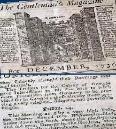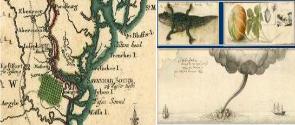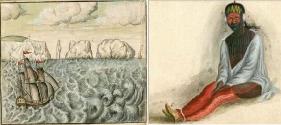| The First Impressions |
| 25-year-old Baron Philip von Reck, who accompanied the settlers, wrote the following optimistic description of the site, which would later be found to be unsatisfactory, in his journal. On March 15, 1734, James Oglethorpe, von Reck, Reverend Israel Gronau and two Salzburgers left Savannah to search for a site for settlement. They agreed on a location two days later on a creek about twenty miles northwest of Savannah. At first, they were excited by it: "We continued our Journey, and set out by Break of Day, and at nine arrived at the Place where the Saltzburgers were afterwards settled. I shall here give a short description of it. The Lands are inclosed between two Rivers, which fall into the Savannah. The Saltzburg Town is to be built near the largest, which is called Ebenezer...and is navigable, being twelve Foot deep. A little Rivulet, whose Water is as clear as Crystal, glides by the Town; ....another runs through it, and both fall into the Ebenezer. The Woods here are not so thick as in other Places. The sweet Zephyrs preserve a delicious Coolness, notwithstanding the scorching Beams of the Sun. There are very fine Meadows, in which a great Quantity of hay might be made with very little Pains: there are Hillocks, very fit for Vines. The Cedar, walnut, Pine, Cypress, and Oak, make the greatest Part of the Woods. There is found in them a great Quantity of Myrtle Trees, out of which they extract, by boiling the Berries, a green wax, very proper to make Candles with. There is much Sassafras, and a great Quantity of those Herbs of which Indigo is made, and Abundance of China Roots. The Earth is so fertile, that it will bring forth anything that can be sown or planted in it; whether fruits, Herbs, or Trees. There are wild Vines, which run up to the Tops of the tallest Trees; and the Country is so good, that one may ride full gallop 20 or 30 Miles an end. As to Game, here are Eagles, Wild Turkies, Roe-Bucks, Wild Goats, Stags, Wild Cows, Horses, Hares, Partridges & Buffaloes." An Extract of the Journals of Mr. Commissary Von Reck, Who Conducted the First Transport of Saltzburgers to Georgia; An Account of Reverend Mr. Bolzius, One of their Ministers. 1734. 'The Salzburgers arrive in Georgia' Mar. 5. A. S. S. W. arose, which carried us, through the Mercy of Jesus Christ, within sight of Carolina. We sung Te Deum, and the 66th Psalm, which was the Psalm for the Day, and seemed adapted to our Condition and Circumstances: and we trust it will be a Psalm of Rememberance to us upon the Day, which is to be celebrated every Year, as a Thanksgiving unto the Lord, for all his Mercies vouchsafed unto us. At Eleven in the Forenoon, we discovered the Coast of Carolina, all covered over with large Pine Trees. The Wind being N. W. by W. contrary, we could not reach the Point of Charlestown, so that we were forced, as we had been in our Voyage from Rotterdam to Dover, to stand off and on several times, in order to get more Wind. God acts, with us, as he did with the Israelites: Joshua was to circumcise all those who were willing to enter into Canaan: so God is willing to circumcise; amend, and convert our Hearts, before he let us disembark. Towards Evening, we met an English Ship, which came from Charlestown this Afternoon, and was bound for London. He told us the agreeable News of Mr. Oglethorpe's being safely arrived the Night before at Charles-town, in his Way to England, which mightily rejoiced and comforted us. Mar. 6. At six in the Morning, the Wind blowing hard at West, we lost Sight of Land; though at Noon, the Wind coming to the South, we saw Land again: but Night approaching, we lay off and on. Mar. 7. At Nine, there came from Charles-town, a Pilot on Board our Ship, we immediately cast Anchor; and at Ten, the Captain, the Reverend Divines, and I went into the Pilot's Boat. At one in the Afternoon, we came to Charles-town, where I immediately waited on his Excellency Robert Johnson Esq; and Mr. Oglethorpe. They were glad to hear that the Saltzaburgers were come within six Leagues, all safe and in good health, without the Loss of any one Person. Mr. Oglethorpe showed me a Plan of Georgia, and gave me the Liberty to choose a Settlement for the Saltzburgers, either near the Sea, or further in the Continent. I accordingly accepted his Favour, and chose a Place 21 Miles from theTown of Savannah, and 30 Miles from the Sea, where there are Rivers, little Hills, clear Brooks, cool Springs, a fertile Soil, and plenty of Grass. Charles-town is a fine Town, and a Sea-Port, and enjoys an extensive Trade. It is built on a Flat, and has large Streets: the Houses good, mostly built of Wood, some of Brick. Wheat Bread is very dear here, there being no Wheat Flour but what Gentlemen raise upon their Plantations for their own Use, and that is very good; or what they receive from the Northern Colonies, or from England; Rice is here excellent and cheap. There are five Negroes to one White, and there are imported generally 3000 fresh Negroes every Year. There are computed to be 30,000 Negroes in this Province, all of them Slaves, and their Posterity for ever: They work six Days in the Week for their Masters without pay, and are allowed to work on Sundays for themselves. Baptism is rarely here administer'd to the Children of the Negroes, and Marriage is not in use amongst them; but they are suffer'd promiscuously to mix, as if they were a Part of the Brute Creation. Being thus used, lays amongst them a Foundation of Discontent; and they are generally thought to watch an Opportunity of revolting against their Masters, as they have lately done in the Island of St. John and of St. Thomas, belonging to the Danes and Sweeds; and it is the Apprehension of these and other Inconveniences, that has induced the Honourable Trustees for Georgia, to prohibit the Importation and Use of Negroes within their Colony. Mr. Oglethorpe sent on Board our Ship, by the Pilot's Sloop, a large Quantity of fresh Beef, two Butts of Wine, two Tunn of Spring Water, Cabbage, Turnips, Radishes, Fruit, &c. as a present from the Trustees, to refresh the Saltzburgers after their long Voyage; for which Kindness (under God) we cannot be sufficiently thankful to them. Mar. 8. We thought this Morning to have gone with the Pilot's Long Boat, on Board our Ship the Purrysburg, for the Captain had taken here a Pilot, to bring us into the River Savannah. Mr. Oglethorpe had given us for our Guide Mr. Dunbar, who knows the Country very well, and was already settled in Georgia, near the Place appointed for us. We thought, I say, to have gone this morning; but the Boat was too much loaded, and theWind, which was E. S. E. though favourable for Georgia, was contrary for us to reach our Ship. We returned to the Town, and lay there. Mar. 9. We beg'd of God, that he would permit us to go to our Georgia. . We went away this Morning at ten, and got on Board our Ship at two in the Afternoon. Mar. 10. God blessed us this Day with the Sight of our Country, our wish'd for Georgia, which we saw at ten in the Morning; and brought us unto the Savannah River, and caused us to remember the Vows we had made unto him, if He did through his infinite Goodness bring us hither. We were to day very much edified with the xxxii Chapter of Genesis, and the xxvi of Leviticus. At Noon, we cast Anchor because of the Tide: at eight, during the Evening Prayers, we enter'd the River of Savannah; and were shelter'd by the Divine Goodness, from all Dangers and Inconveniencies of the Sea. This River is in some Places broader than the Rhine, and from 16 to 25 Foot deep; and abounds with Oysters, Sturgeon, and other Fish. Its Banks were cloathed with fresh Grass; and a little beyond were seen Woods, old as the Creation; resounding with the Musick of Birds, who sung the Praise of their Creator. (end) |
| Ebenezer Creek is a tributary of the Savannah River and the unusual river swamp consists of unique virgin dwarfed bald cypress trees, some estimated to be more than 1,000 years old. Eight miles of the tributary creek are a type of stretched out lake created by the damming effect of natural levees and water levels of the Savannah River, which, when it rises to a certain height during seasonal floods or heavy rains, backs up water in the Ebenezer tributary like the action of a tide. This "lake" section rarely goes dry, and its water levels can fluctuate as much as 8 feet and stay high for prolonged periods. The creek does not always have water of good quality, but it has alligators, fish, turtles, snakes and many species of birds and, unfortunately, a great deal of insects. Baron von Reck kept a vivid diary and made detailed sketches and maps of New Ebenezer during his visit to that settlement in 1736. Many of the invaluable sketches depict native plant and bird species as well as noting the customs and dress of the local Indians and give us an accurate impression of what greeted the Salzburgers and what a culture shock it must have been for the simple mountain folk who had never seen the ocean, let alone alligators. Not much is known about the elusive Baron von Reck. Von Reck provided the only real glimpse into the early days of Ebenezer. A short time after they arrived, the Salzburgers were followed by missionary John Wesley, founder of Methodism, and a large group of Scottish highlanders who also found a new home in Georgia. Wesley was not so romantic in his assessment: "The land is a hungry barren sand; and upon any sudden Shower, the Brooks rise several Feet perpendicular, and overflow whatever is near them, and the Water is generally so low in Summer that a Boat cannot come within 6 or 7 miles of Town." Indeed, of 44 named passengers on the ship Purysburg, 20 of them would die in 1734 and 1735, mainly from malaria and dysentery, and by January of 1736, another 21 Salzburgers had perished. Ebenezer's first location proved too far from the Savannah River, the soil quality was poor and there was frequent flooding in the area. The Salzburgers received permission to move to a far better new site on a knoll where the Ebenezer Creek entered the Savannah River, and here they built New Ebenezer in 1736, which was laid out on a grid pattern with open squares. In 1735, Britain's Parliament not only funded the entire £25,800 requested by the Trustees for support of Georgia for the coming year, they threw in an additional £200. The Salzburger settlement grew later to 1,200 after another 300 Immigrants joined them in 1741. Other transports arrived until 1752. In 1769, they formed bricks with clay dug from the Savannah River banks for a new church, the Jerusalem Evangelical Lutheran Church. |
| Above (click), the London Merchant sails for America in 1738, some of Von Reck's sketches, a map of area of New Ebenezer on the Savannah River, prepared for Samuel Urlsperger and published by Matthaeus Seutter in 1747. A period London newspaper on the right makes mention of the Salzburgers: "The trustees for the colony of Georgia gave instructions to Mr Von Reck to fetch more Protestants from Germany to be provided for in Georgia; those already there proving a very religious, diligent, and governable people". Back in London, the emigration was of interest and updates would be printed in the London media. |
| THE SALZBURGERS: GEORGIA |


